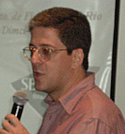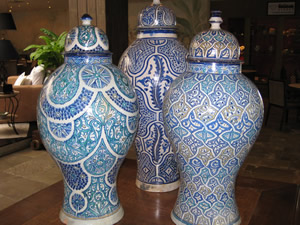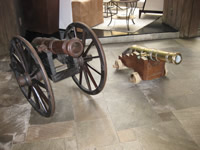
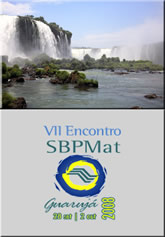


SPI Supplies
Silicon Nitride Membrane
Window Grids

MMR Technologies
Microcryogenic
and
Thermal Stage Systems

National
Electrostatics Corp.
Ion Beams
RBS, PIXE,
AMS

Huntington Mechanical Labs
Better-Built Vacuum Components
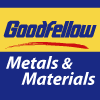
Goodfellow
Small quantities … fast!
|
DAY 5
The 7th Brazilian MRS Meeting (VII Encontro SBPMat) 2008 concluded on Thursday after four days of plenary talks, oral presentations, poster sessions, the exhibit, the banquet dinner and other events. Overall, this was another very successful meeting for the Brazilian-MRS with over 1200 attendees, including 700 students. The next Brazilian-MRS annual conference is the IUMRS-ICEM 2009 meeting in Rio de Janeiro next year. Symposium A: Novel Hybrid Organic-Inorganic
Multifunctional Materials
In a contributed paper to Symposium A, Marco Carmona, from the Department of Physics, PUC-Rio, Brazil, and Dimat/Dimci, Inmetro, Duque de Caxias, RJ, Brazil, described experimental and theoretical efforts for the determination of the UV degradation mechanism in organic light emitting diodes (OLEDs). The particular OLED investigated was thin films of tri(8-hydroxy)quinolone-aluminum (Alq3). Carmona first cited literature that used white light to measure degradation as a function of time, and hypothesized from FTIR spectra that the mechanism involved breakage of Al-O bonds. Carmona and co-researchers in his group improved on these experiments by measuring photodegradation, measured by a decrease in photoluminescence, as a function of exposure to a radiation wavelength – 357 nm – that falls within the absorption band of Alq3. Concomitant to the decreasing photoluminescence, Carmona and co-researchers also observed the appearance of the peak in the FTIR spectra that was previously attributed to Al-O bond breakage. Carmona collaborated with computational chemists, who used density functional theory to obtain the optimal geometries of three forms of Alq3, including the geometry with no broken bonds, forms with Al-O bonds broken, and a form with a broken phenoxide ring bond. Calculated IR spectra showed that the degradation mechanism involves breaking of the phenoxide ring bonds, not with Al-O bond breakage.
Symposium A: Novel Hybrid Organic-Inorganic
Multifunctional Materials Perotti cast nanocomposite films from mixtures of never-dried cellulose strips and varying amounts of Laponite colloid dispersions. Characterization of the dehydrated films, performed with x-ray diffraction, FTIR vibrational spectroscopy, thermal gravimetric analysis-mass spectroscopy (TGA-MS), and scanning electron microscopy, suggested to Perotti the formation of intercalated hybrid structures, with the clay nanoparticles interfering with the packing of the cellulose biopolymers. The TGA-MS revealed two main weight-loss steps: film dehydratation between 25-150ºC; partial polymer thermal decomposition at 400ºC; and Laponite dehydroxylation at 700ºC. Cellulose thermal stability was observed only for films with high clay content. Clay loading severely decreases the porous regions on the cellulose, perhaps due to filling by Laponite nanoparticles, and also causes a notable change in the film’s surface topography.
Symposium C: Mechanical Properties of Surfaces,
Thin Films, and Coatings
In an invited talk in Symposium C, Prof. Deniol Katsuki Tanaka, from the Polytechnic School, University of São Paulo, Brazil, inspired an audience composed mostly of Brazilian students not to be afraid of failure because, as shown from his study of Leonardo da Vinci, that is how one learns and improves. Tanaka said that all of Leonardo’s surviving paintings remain unfinished, and that he never completed a single work; all were in-progress. Although Freud ascribed this behavior, which he called “Leonardo’s complex,” to being rejected by his mother (Leonardo’s father was a “playboy” and his mother was an Arab slave, who bore Leonardo illegitimately and then married and had several legitimate children – half-siblings of Leonardo), Tanaka maintains that Leonardo was forever trying to improve his creations. Early in life, Leonardo was sent to Milan to become a musician, and, although he is well known for his paintings and sculpture, he described himself as an engineer, seeking work as a military engineer at age 27 even though he disapproved of war. Through improving his machines, Tanaka says that Leonardo discovered the laws of friction, even though he never used the word in his writings (in the 7,000 pages that survived, that is; Leonardo wrote about 13,000 pages during his life). Leonardo did use the word “rubbing” to describe static and dynamic friction. He wrote that the force required to start motion is bigger than force needed to stop it. Tanaka demonstrated that Leonardo recognized the systemic nature of tribology and he was concerned with the conceptual confusions and misuse of the word friction as synonymous of relative movement and not as an event of energy loss. In fact, this perception of energy was first conceived by Leonardo. Finally, Tanaka presented specific aspects of Leonardo’s tribological studies, such as the effects of surface finishing, the presence of lubricant and solid particles at the interface, the development of tribological experimental devices, and the design of tribological components, such as the ball bearing, to reduce or eliminate “friction”.
Symposium D: Powder Processing of Novel Materials
While most talks at the conference have reported on scientific research, Dr. Henri Cohrt in his invited talk gave an industrial perspective on the issues faced when an actual product is manufactured. The powder injection molding process is widely used to produce high precision structural parts with very high complexities in shape. The variety of materials that are used in this process ranges from ceramics and hard materials to stainless steels and low alloyed steels. As a near net shape process the entire process is very complex. Cohrt described some of the principle defects possible in the process and materials and ways to minimize these and control the quality of the final product. Early design activities influence the quality of the final product as well as the tool design and fabrication, the selection of raw material and binder system, and all single production steps and the secondary operations. A well designed quality management and control system is critical to control the powder injection moulding process in all details. He went on to describe such a quality management and control system in detail. The idea behind quality management is to avoid errors, as compared to quality control which attempts to find errors. He suggested that a quality management system should be regarded as a tool for never ending improvement of the metal/powder injection molding process. The combination of a high performance process monitoring system with the extensive application of statistical procedures creates the basis for a Statistical Process Control (SPC) system that meets all the requirements to produce multi-functional structural parts of high complexity in shape and of high performance materials. He also stressed that customer satisfaction eventually should be the paramount factor in any production process.
Symposium E: CIAM Scientific
Meeting
The Materials World Network (MWN) was established in 1995 and was developed through a series of seven materials workshops sponsored by the US National Science Foundation. In his talk on Monday in symposium E, Prof. Robert Chang (Northwestern University, USA) described the past and current activities of MWN and had a proposal for the future for the Brazilians. Supported by a framework of joint funding agreements between NSF and many of its counterpart agencies worldwide, MWN currently connects a diverse community of research centers, academic institutions, national laboratories, technical societies, and industry partners around the world. Based on joint ownership and universal participation, MWN promotes collaborations among developing and developed countries, with Brazil paying a significant role, and serves as a platform for addressing global challenges via materials science, education, and technology. After giving background information and details of previous activities for MWN, Chang then proposed the future establishment of a Pan-American Global E-Institute (GEI) to address global challenges occurring at the intersection of energy, environment and the economy. This would be phase I. In phase II, an alliance of worldwide E-Institutes could be set up. Chang gave the rationale for why the Pan American partners are in an excellent position to lead this initiative. He also suggested several potential activities at the 11th IUMRS-ICAM 2009 conference next year in Rio de Janeiro, including a planning meeting, a global nanotechnology workshop, and a global school for advanced studies setup. He also suggested a program model for the GEI. He suggested contacting him for further information and with comments at mri@northwestern.edu.
Symposium L: High Resolution Electron
Microscopy
In a symposium L talk on Monday, Paulo F. P. Fichtner (Universidade Federal do Rio Grande do Sul, Porto Alegre, Brazil) described crack interaction phenomenon in H and He implanted Si. A recent technique based on the controlled formation of crack-like defects induced by ion implantation has novel possibilities for substrate engineering in microelectronics, photonics and other advanced devices. HRTEM was used to image platelets and crack-like defects in H and He co-implanted Si (001). The H platelets and He plates act as individual nano-objects. A technique to produce a specific crack system was investigated studied. Upon He implantation and annealing, primary plate-like defects are formed. Further implantation of H at 200°C produces a damaged layer which consists of long, sharp and straight cracks. Some interesting behavior of crack interaction was observed. Twin triggered defects containing nanocrystallites of low and high angle grain boundaries, dislocations and disordered zones are shown to occur between two approaching cracks tips. This indicates the high stress developed in this region. Partially unexpected interactions may occur when two coplanar cracks propagate toward each other. In a first phase, the cracks approach each other, as predicted by theory. However, as the distance shortens, the crack tips slightly deviate from the propagation direction and do not coalesce along the shortest path. The cracks run around each other at a certain distance until, they finally merge. In summary, it was shown that H platelets can be organized into nanoscale domains and the arrangement is determined by the symmetry of the local strain field. This was modeled with good agreement with experimental observations. The results suggest a basis for the technique to create localized arrangements of nanoscale precipitates using bottom-up strain engineering. The authors anticipate applying this to other precipitate-matrix systems. They also plan on using other strain sources to produce distinct precipitate arrangements. They are also developing a 3-D model for the system investigated. Symposium P: VI Brazilian Symposium on
Electroceramics In an invited talk, E.R. Leite, from LIEC-DQ-UFSCar, S. Carlos, SP, Brazil, reported on the development of nanostructured α-Fe2O3 thin films for water photo-oxidation and offered his insights into nanoarchitecture design. Worldwide research has focused in recent years on the conversion of sunlight into hydrogen as a clean and renewable energy source. Leite cited classic research showed that it is possible to induce water-splitting by sunlight, using the TiO2 semiconductor as the photoanode. However, TiO2 has a wide bandgap and is therefore photoexcited only by UV light, which is only about 5% of the solar spectra. The main focus of Leite‘s research is new photoanodes active in the visible region of the solar spectrum in order to increase the energy conversion efficiency. Leite chose the iron oxide Hematite (α-Fe2O3 ) because it is a semiconductor material with a narrow bandgap (approximately 2.2 eV) and has very good electrochemical stability in water, making it an especially good candidate for a photoanode for splitting water into oxygen and hydrogen by sunlight. Theoretical calculations suggest that α-Fe2O3 has a maximum efficiency of 12.9% but the reported water splitting efficiency for α-Fe2O3 is much lower. Leite presented several newly nanostructured α-Fe2O3 anodes, although none performed with efficiencies approaching the theoretical maxima. He also presented a few promising nanoarchitectures, however, he has not yet determined how to make them.
ABOUT THE MEETING SCENE
© Materials Research Society, 2008 |

